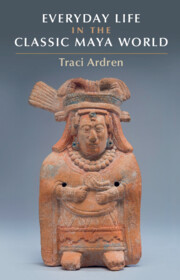2 - The Domestic World
Published online by Cambridge University Press: 01 June 2023
Summary
Most ancient Maya people spent the majority of their lives in and around domestic settings. Activities and experiences that occurred here shaped not only what people did every day, but how they thought about themselves in many important ways. Even kings and queens, with their very different living quarters, had rituals they performed for their subjects that reenacted the daily habits of simple domestic compounds. Living structures varied according to one’s access to resources: royal families lived in roomy palaces made of stone, with plaster- and mural-covered walls and a high, vaulted ceiling. These buildings were often situated on small hills or artificial platforms to catch the breeze and prevent flooding during tropical rains. Middle-society homes were set atop smaller platforms, and may have had a plaster floor, but the walls of these homes were made of wood and the roofs of thatch. The simplest homes were set on the bedrock or ground level, with a packed dirt floor, wooden walls, and a thatch roof. Ironically, the wooden homes had many advantages over stone palaces – they allowed for more light and air to circulate, making them drier and in some cases cooler, and the materials to construct or repair these simple homes were easily available in the wetlands or forest outside Maya cities. However, they were very vulnerable to fire, especially during the dry season when an attack of flaming arrows could easily set an entire neighborhood aflame. Surrounding the central palaces and temples of ancient Maya cities were thousands of domestic or residential compounds, clusters of small houses, patios, and gardens occupied by extended multigenerational families of parents, children, spouses, and grandparents. In the 16th century, Spanish cleric Bishop Diego de Landa recorded that the Maya people of Yucatan had a matrilocal marriage practice, meaning that young men would move into the residential compound of their wives, so it is likely that multiple generations of family members lived together for most of their lifetime. Many of the tasks that took place in a compound, such as tending small animals, weaving, or gardening, were made easier by the collective efforts of an extended group of relatives.
- Type
- Chapter
- Information
- Everyday Life in the Classic Maya World , pp. 24 - 45Publisher: Cambridge University PressPrint publication year: 2023



